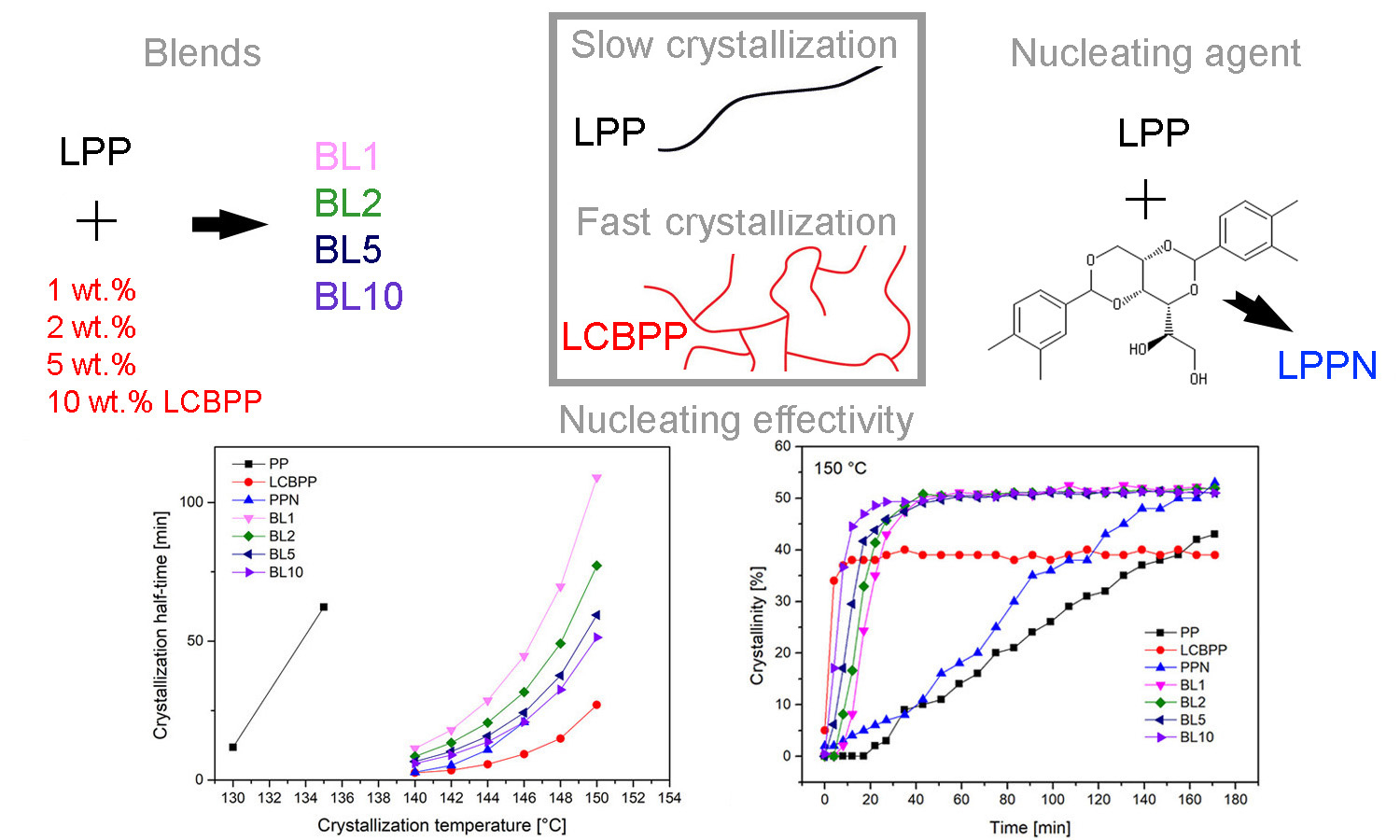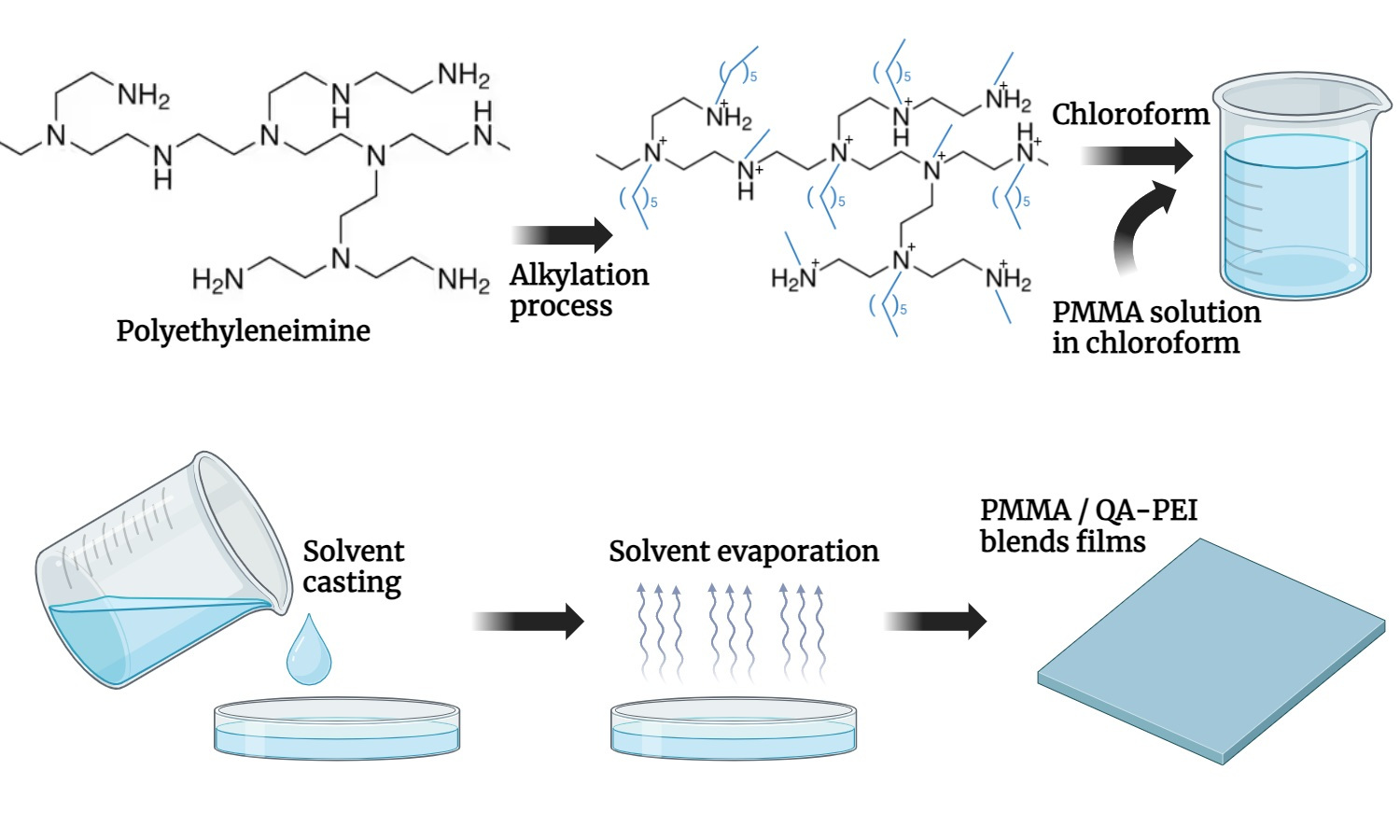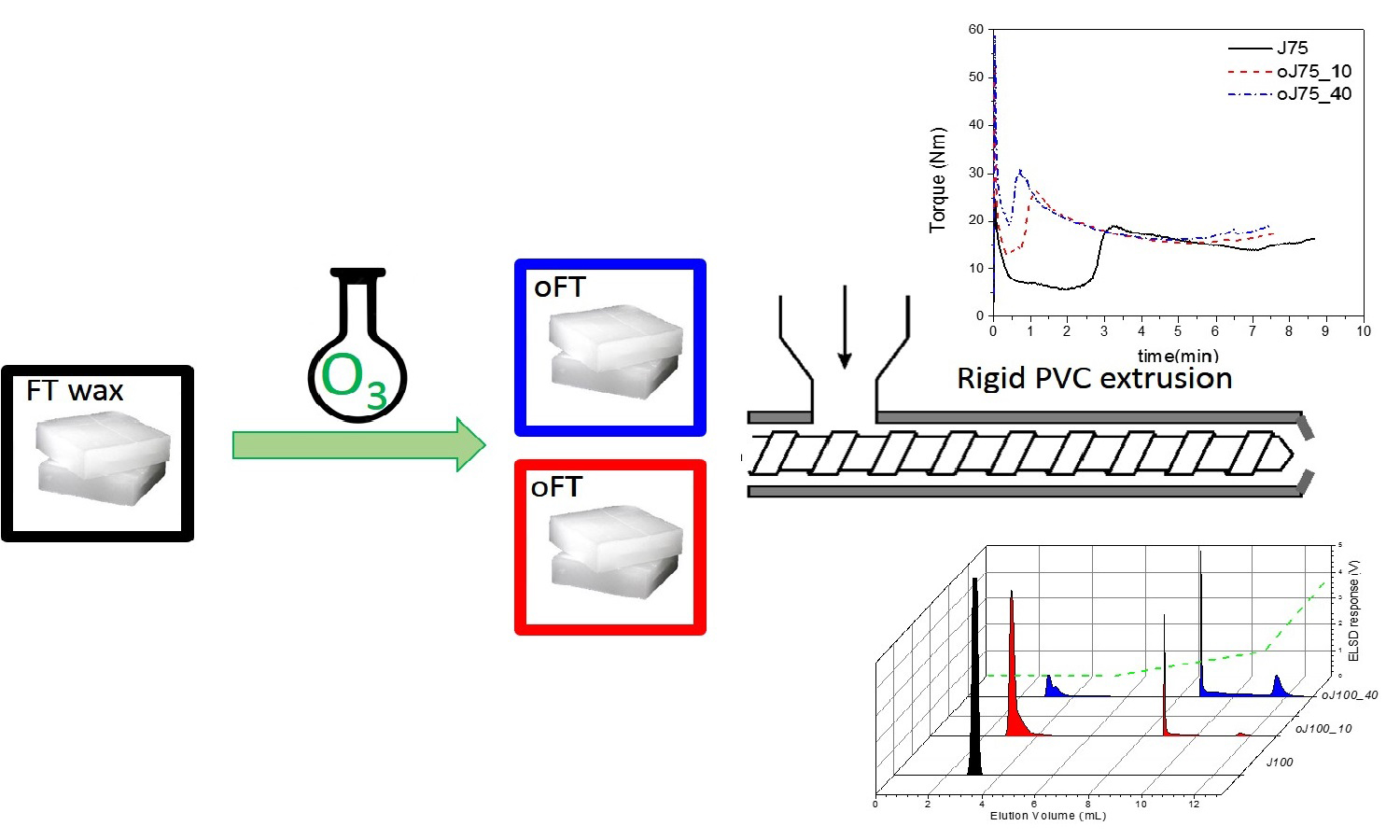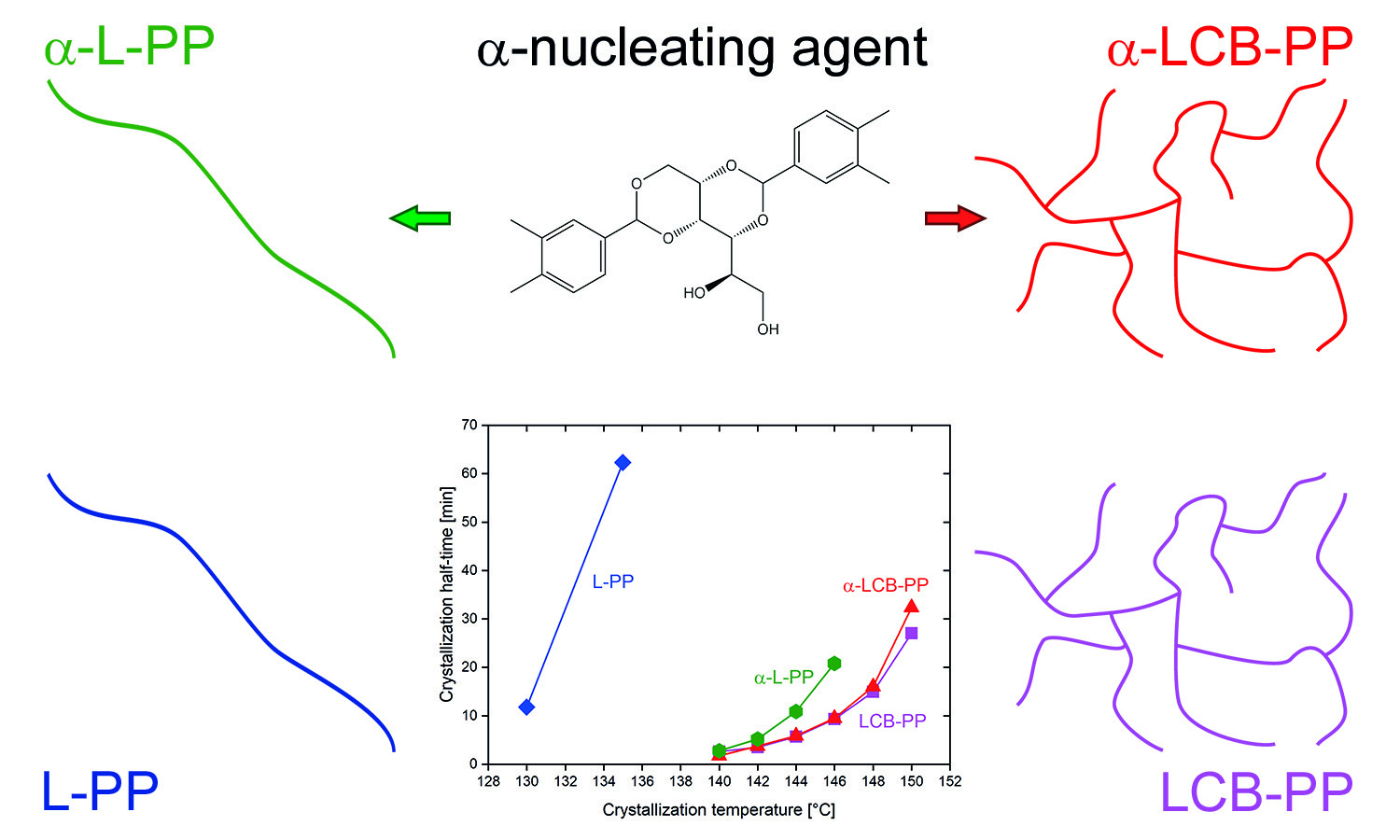Polypropylene blends: Impact of long chain-branched polypropylene on crystallization of linear polypropylene
Soňa Zenzingerová , Jana Navratilova
, Jana Navratilova , Lenka Gajzlerová
, Lenka Gajzlerová , Michal Kudláček
, Michal Kudláček , David Jaška
, David Jaška , Lubomir Benicek
, Lubomir Benicek , Roman Čermák
, Roman Čermák
 , Jana Navratilova
, Jana Navratilova , Lenka Gajzlerová
, Lenka Gajzlerová , Michal Kudláček
, Michal Kudláček , David Jaška
, David Jaška , Lubomir Benicek
, Lubomir Benicek , Roman Čermák
, Roman Čermák
Vol. 18., No.9., Pages 921-930, 2024
DOI: 10.3144/expresspolymlett.2024.69
DOI: 10.3144/expresspolymlett.2024.69
GRAPHICAL ABSTRACT

ABSTRACT
This study compares the efficiency of commercially available sorbitol-based clarifying agent (NA) and varying amounts of long chain-branched polypropylene (LCBPP) acting as a specific α-nucleating agent for linear polypropylene (PP). The sorbitol-based clarifying agent, 1,3;2,4-bis(3,4-dimethyl benzylidene)sorbitol (Millad 3988), in concentration 0.2 wt%, and LCBPP in the concentration of 1, 2, 5 and 10 wt% were mixed into PP. The comparison of the effect of NA and long branches under isothermal conditions on the crystallization process, crystallinity and polymorphic composition was realized by differential scanning calorimetry and wide-angle X-ray scattering. The addition of long chain-branched polypropylene, even at the lowest concentration, performs better at higher crystallization temperatures and has a superior effect on the crystallization process, crystallization rate and overall crystallization than the addition of NA.
RELATED ARTICLES
Dazhi Zhu, Junhao Wang, Yongheng Sun, Jianqiang Chu, Zhaobo Wang
Vol. 19., No.4., Pages 361-371, 2025
DOI: 10.3144/expresspolymlett.2025.27
Vol. 19., No.4., Pages 361-371, 2025
DOI: 10.3144/expresspolymlett.2025.27

In this research, heat-triggered triple-shape memory polymers (TSMPs) based on the ethylene-methyl acrylate copolymer (EMA)/chloroprene rubber (CR) thermoplastic vulcanizates (TPVs) were prepared by dynamic vulcanization successfully; meanwhile, an effective and facile triple-shape memory strategy was designed to realize the efficient and stable shape fixity and recovery of two temporary shapes. The field-emission scanning electron microscope images showed that EMA/CR TPV surface was a sea-island structure with the CR particle size ranging from 3 to 6 μm. Differential scanning calorimeters and X-ray diffraction were used to investigate the crystallization behavior of both EMA and CR. These served as a significant basis for the two temporary shapes: fixity and recovery. The results of triple-shape memory tests showed that the EMA/CR TPV had excellent triple-shape memory properties, where the first shape fixity ratio was higher than 89% and both the first shape recovery ratio and second shape recovery ratio could be higher than 95%. It can be observed that the EMA/CR TPV exhibited rapid shape recovery speed with the first shape recovery time of 10 s and the second shape recovery time of 20 s, respectively. This research presents a novel approach to extending the application of TPV in the field of smart devices, endowing them with excellent mechanical and triple-shape memory properties.
Rafael Affonso Netto, Guilherme Ribeiro de Carvalho, Lucas Henrique Staffa, Liliane Maria Ferrareso Lona
Vol. 19., No.2., Pages 161-175, 2025
DOI: 10.3144/expresspolymlett.2025.12
Vol. 19., No.2., Pages 161-175, 2025
DOI: 10.3144/expresspolymlett.2025.12

This study aimed first to promote the alkylation of polyethyleneimine (PEI), developing its alkylated (quaternary) form (QA-PEI) by inserting alkyl groups into amine groups. Subsequently, polymer blends with poly(methyl methacrylate) (PMMA) were prepared via solvent casting, and finally, the physicochemical, optical, and mechanical behavior of the resulting PMMA/QA-PEI were assessed. Elemental analyses, Fourier-transform infrared spectroscopy (FT-IR), and hydrogen nuclear magnetic resonance spectroscopy (1H-NMR) confirmed that the PEI alkylation successfully converted the amine groups into quaternary ammonium groups. When added to PMMA, QA-PEI altered its coloration, making it yellow. In addition, higher contents of QA-PEI hindered PMMA transmittance and increased its opacity due to the larger QA-PEI domains. Scanning electron microscopy (SEM) images showed that PMMA and QA-PEI formed a phase-separated system, establishing a droplet-matrix morphology. The thermal and mechanical behavior showed some compatibility between PMMA and QA-PEI as thermal resistance slightly improved and PMMA glass transition temperature (Tg) decreased. The tensile strength was also improved in the PMMA/QA-PEI blends without significant change in strain at break and tensile modulus.
Johannes Lodewiekus Barnard, Divann Dale Robertson, Albert Johannes van Reenen
Vol. 18., No.2., Pages 118-132, 2024
DOI: 10.3144/expresspolymlett.2024.10
Vol. 18., No.2., Pages 118-132, 2024
DOI: 10.3144/expresspolymlett.2024.10

A set of linear Fischer-Tropsch (FT) waxes were oxidized to various degrees by utilizing an ozonolysis method. These waxes were comprehensively characterized in terms of their chemical composition, thermal behaviour, molecular weight distributions, and overall polarity using various analytical techniques, including Fourier transform infrared spectroscopy (FTIR), nuclear magnetic resonance spectroscopy (NMR), differential scanning calorimetry (DSC), high temperature size exclusion chromatography (HT-SEC) along with normal and reverse-phase high temperature solvent gradient interaction chromatography (HT-SGIC). Application-based studies were performed by evaluating the behaviour of these waxes in unplasticized polyvinyl chloride (uPVC) formulations. Analyses included hot melt mixing, single screw extrusion, scanning electron microscopy coupled with energy dispersive X-ray spectroscopy (SEM-EDS), and torque rheometry. Through a combination of these techniques, the lubrication mechanism of these waxes could be explained by the Rabinovitch model. It was found that a combination of molecular size and degree of polarity play a vital role in the migration of the waxes and therefore ultimately impacts the fusion behaviour of the overall polyvinyl chloride (PVC) formulation. Results indicate that fusion times can greatly be altered when using oxidised waxes, and this could be promising for the development of multifunctional lubricant systems.
Sona Zenzingerova, Michal Kudlacek, Jana Navratilova, Lenka Gajzlerova, David Jaska, Lubomir Benicek, Roman Cermak
Vol. 17., No.11., Pages 1110-1120, 2023
DOI: 10.3144/expresspolymlett.2023.84
Vol. 17., No.11., Pages 1110-1120, 2023
DOI: 10.3144/expresspolymlett.2023.84

The
main purpose of this work is to present the effect of long-chain branching and
specific α-nucleation on the optical properties, crystallization and
supermolecular structure of polypropylene (PP). Commercially available α-nucleating/clarifying
agent 1,3;2,4-bis(3,4-dimethylbenzylidene)sorbitol (Millad 3988) was mixed into
linear PP and long-chain branched PP (LCB-PP) in the concentration of 0.2 wt%.
For the study of polymorphic composition, crystallinity, and crystallization process
under isothermal conditions in the temperature range of 130–150 °C,
differential scanning calorimetry and wide-angle X-ray scattering were used.
Although the used nucleating/clarifying agent appears to have a slight effect
on the optical properties of long-chain branched polypropylene, it does not
appear to affect the crystallization kinetics significantly. LCB-PP exhibited
self-nucleation, favored over nucleation by a specific nucleating agent.



